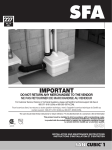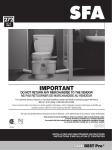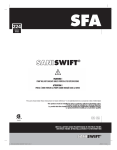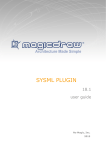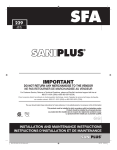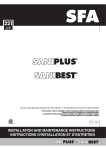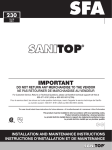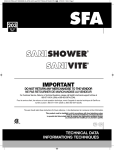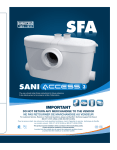Download Saniflo 029 Use and Care Manual
Transcript
226 1 10.12 IND1 IMPORTANT DO NOT RETURN ANY MERCHANDISE TO THE VENDOR NE PAS RETOURNER DE MARCHANDISE AU VENDEUR For Customer Service, Returns or Technical Questions, please call Saniflo’s technical support toll-free at 800-571-8191 (USA) or 800-363-5874 (CDN). Pour le service client, les retours ou toute question technique, merci d’appeler le service technique de Saniflo au numéro suivant : 800-571-8191 (USA) ou 800-363-5874 (CDN). The user should retain these instructions for future reference • A lire attentivement et à conserver à titre d’information This product must be installed in strict accordance with local plumbing codes. Product should be installed by a licensed plumber. Le produit doit être installé dans le respect des règlements sanitaires locaux. Le produit doit être installé par un plombier qualifié. 226615 CDN USA INSTALLATION AND MAINTENANCE INSTRUCTIONS INSTRUCTIONS D’INSTALLATION ET D’ENTRETIEN 1-1/2” 1-1/2” 1 1-1/2”/4” 1-1/2”/4” 1-1/2”/4”* 1-1/2”/4”* 2 A x2 B x2 C x8 D x4 E 40/60 x2 F x2 G x2 H x2 x4 J x1 K x2 L O x1 10/16 100/120 32/50 N 3 x1 6 feet * * 7 6 P1 Vertical Height (feet) Hauteur (feet) 33 30 27 24 21 18 15 12 9 6 3 0 P1+P2 1% maxi 36 Ft 29 Ft 1% 23 Ft 1% 19 Ft 1% 16 Ft 1% 13 Ft 1% 10 Ft 6 Ft 25 30 35 40 45 50 55 60 65 70 75 80 OK maxi 98 Ft SFA maxi 131 Ft maxi 164 Ft maxi 197 Ft maxi 229 Ft SFA maxi 262 Ft maxi 295 Ft 1% maxi 328 Ft 1% 3 Ft 20 8b 1% 26 Ft maxi 360 Ft 85 90 P1 Flow Rate with 1 motor (gallons/min.) Débit (gallons/min.) avec 1 moteur P1+P2 Flow Rate with 2 motors (gallons/min.) Débit (gallons/min.) avec 2 moteurs * cf. maxi 65 Ft 1% 1% SFA 8 8d 8b D 3 1 D 1-1/2’’ 2 8e J 1 2 3 J J F J F 8f 8g 2 1 1 C D 3 N C O 2 8h L SFA B H G L L A 9 SANICUBIC® 2 Société Française d’Assainissement EN 12050-1 R300 LC 220-240 V - 60 Hz 2 x 1 HP - 226615 The numbers refer to the explanatory diagrams. 1 DESCRIPTION 6 PERFORMANCE CURVE ® The SANICUBIC 2 is a lifting station designed to evacuate effluent from small private or commercial units. Please comply with all the installation and maintenance specifications set out in these instructions, and especially the information marked with the following signs: « » Failure to comply with this information could entail safety hazards for personnel, « » Information warning of the presence of an electrical hazard, « » Instructions only for qualified professional specialists, «WARNING» Failure to comply with this information could affect the normal operation of the equipment. Please contact our Customer service for further information. SANICUBIC OPERATING PRINCIPLE SANICUBIC® 2 contains 2 separate pumps. Each of the pumps is fitted with a high-performance macerating system. The 2 pumps operate alternately. In the event of inflow overload, both motors run at the same time (or if one of the pumps is faulty, the other one takes over). The SANICUBIC® 2 tank is fitted with 2 dip tubes; one tube controls motor operation, and the other one controls the alarm system. - Long pickup tube (normal operation): as soon as the waste water level in the tank reaches the triggering point in the long tube, the pumping system starts up. - Short pickup tube (inflow overload operation): if the waste water level in the tank reaches the upper point, a contact is closed, and the auxiliary pumping system is triggered. The contact also sets off an visual alarm. The general alarm LED on the SANICUBIC® 2 control panel switches to red. 2 LIST OF PARTS SUPPLIED 3 DIMENSIONS 4 TECHNICAL DATA SANICUBIC® 2 Type Maximum discharge head Voltage Frequency Volume Maximum power input Maximum current input Electrical classification Ave water temp for optimum performance Maximum temperature (intermittent) Protection index Net weight (including accessories) R300 LC 36 Ft 220-240V 60 Hz 12 Gallons 2 x 1 HP 13 A I 104 F 160 F* IP67 66 Lbs *Hot water drain cycles from dishwashers or washing machines Example: Pump P1 is operating normally. It discharges 38 gpm at a pumping height of 16 Ft. If pump P1 shows any signs of weakness or if the waste water inflow is too great, pump P2 starts up. The output is then increased to about 64 gpm, until the situation returns to normal. 8c If you want to install a shower or a bath at the same level as the SANICUBIC® 2, you must make sure that the upper parts of the plugholes on the sanitary equipment are at least 10’’ above the lower inlets. 7 RATIO OF HEIGHT/LENGTH FOR DISCHARGE 8d 8 INSTALLATION The SANICUBIC® 2 must be installed in compliance with local plumbing codes. The equipment must be commissioned and maintained by a qualified professional specialist. REGULATIONS 1- Attention: the space in which the SANICUBIC® 2 is to be installed must be large enough to leave at least 24’’ of working room around and above the unit to facilitate such maintenance work as may be required. There must be sufficient lighting, and it must be sufficiently well ventilated and protected from freezing. 2- Isolating valves (not supplied) must be fitted on waste inlets (especially the 4’’ inlets) and on the discharge to ensure that any service/maintenance may be carried out safely). 3- The discharge pipe must be fitted so as to avoid all back flow from the drainage system (see the examples in drawing 8g ). Back flow can be avoided by installing an anti-back flow riser reaching a high point above the maximum back flow level. Comment: In the absence of local information to the contrary, the maximum back flow level corresponds to street level (roadway, pavements, etc.). Continue the discharge pipework after the anti-backflow riser, using a larger diameter pipe. 4- If the Sanicubic is installed in a space such as a pit for example, we would recommend the fitting of a bilge pump in case of flooding. 5- The lifting station must be vented with an outlet at roof level. 6- The lifting station must be fixed to the floor (see 8h ). CONNECTING SANITARY EQUIPMENT TO THE LOWER INLETS CONNECTING THE INLETS 1-1/2’’ Lower inlets (cf. 8d 1 ) Upper inlets (cf. 8d 2 ) • Cut off the end of the 1-1/2’’ inlet with a saw • Cut the sleeve D to suit the pipe diameter: 1-1/4’’ or 1-1/2’’ (cf. 8d 3 ) • Fix the sleeve D on the inlet and on the pipe, using the collars. 8a 8b CONNECTING THE DISCHARGE PIPE Remove the end cover or covers from the back of the unit (cf. 8g 1 ). As each pump is fitted with a macerator system, an 1-1/2’’ discharge pipe can be used. The discharge bend is at the centre of the unit, at the back (cf. 8b). Use a standard 1-1/2’’ coupling (not provided) to connect it to the riser pipe and fix it in place with metal clamps. Each pump in the SANICUBIC® 2 unit is fitted with check valves. 8e CONNECTING THE 4’’ INLET Lower inlets (cf. 8e 1 ) 1- Remove the plug from the side inlet. 2- Fix the sleeve F in place using the collar. J . 3- Fully insert the 4’’ tube in the other end of the sleeve and fix it in place using the other collar. J . Upper inlets (cf. 8e 2 ) 1- Cut off the upper end of the 4’’ inlet with a saw. 2- Fix the sleeve F in place using the collar J . 3- Fully insert the 4’’ tube in the other end of the sleeve and fix it in place using the other collar J . 8f CONNECTING THE VENT 1- VENT OF SANICUBIC® 2 One of the upper 1-1/2’’ inlets must be used for the vent. The vent pipe must be fitted up to roof level. Cut off the end of the one of the 1-1/2’’ inlets with a saw. Then fix the sleeve D in place using the collar C . Fully insert the 1-1/2’’ tube in the other end of the sleeve and fix it in place using the other collar C . WARNING: Note that the vent system should be a two-way air vent. The use of mechanical vents, air admittance valves or similar devices are not permitted as these are considered one-way air vent systems. The vent must be an open vent or the unit will not operate. 2- VENTING THE ELECTRICAL PART Connect the 8/11 clear PVC tubing ( N ) supplied to the keyboard on the Sanicubic. The other end of this tubing must be located between 3 Ft and 6 Ft above the device to avoid water getting into the electrical part in the event of flooding. Important: do not pinch the tubing. DRAINING The SANICUBIC® 2 unit is fitted with 2 plugs (8g 1 ). Disconnect the unit from the power supply. To drain the unit 1- Unclip the cover. 2- Remove one of the 2 plugs. 3- Insert a wet utility vacuum cleaner pipe to drain the unit. The port diameter is 1-1/2’’. 4- When the unit has been drained, put the plug and then the cover back in place. 8g FIXING THE SANICUBIC UNIT TO THE FLOOR The SANICUBIC® 2 unit is equipped with fittings to hold it on the floor and prevent it from turning or moving. 8h 1- Place the unit on the desired spot. 2- Draw the outline of the unit. 3- Position the brackets and fix them to the floor as shown on the template diagram (8h 1 ). 4- Put the unit back in place. 5- Fix the unit in place with the screws. 8i ELECTRICAL CONNECTIONS 1- The electrical installation work must be carried out by a qualified electrician. The electrical installation must comply with the standards in force in the country concerned 2- The power supply must be of the class 1 type. The unit must be connected via an earthed connection box. The electric power circuit must be protected by a high-sensitivity 30 mA differential circuit breaker set at 20 A. The connection must be used solely to power the SANICUBIC® 2. If the power lead on the unit is damaged, it must be replaced by the manufacturer or its after-sales service to avoid all danger. EXTERNAL WIRED ALARM REMOTE ALARM MODULE The external alarm box of the SANICUBIC® 2 does not require an independent power supply. It is powered via the circuit board of the SANICUBIC® 2. In the case of a power outage, a battery takes over. red general alarm LED yellow power alarm LED CONNECTING THE ALARM BOX Connect the alarm cable directly to the control panel. The cable can extend for 15 Ft for ease of installation. 1/ The red LED on the alarm box goes off (visual and audible) at the same time that the LED on the mounted control panel does. 2/ The yellow “power” LED shows the status of the power supply for the alarm box : - LED on: normal power - LED flashing: power supply is faulty. 10 CONFORMITY WITH STANDARDS • SANICUBIC® 2 is eligible to bear the CSA mark shown with adjacent indicators “C” and “US”. The “C” and “US” indicators adjacent to the CSA mark signify that the product has been tested according to the applicable CSA (CAN) and ANSI/UL standards for use in Canada and the USA. This includes products eligible bear the designation NTRL. NTRL (Nationally Recognized Testing Laboratory) is a designation awarded by the American Occupational Safety and Health Administration (OSHA) to laboratories authorized to award the certification according to American standards. 11 COMMISSIONING 9 ALARM OPERATION 1/ General alarms: High level alarm: If the water level in the unit is abnormally high: the red LED comes on; the other motor starts up 3 seconds later (see the illustration showing the control keyboard). Temporary alarm: If one of the 2 motors runs for more than 1 minute: the red alarm LED comes on; the other motor starts up 3 seconds later. 2/ Resetting the general alarms: If the problem that has triggered one of the alarms referred to above ceases, the red alarm LED stays on to memorize the fact that the system has met with a problem. The “Reset alarm” key on the keyboard switches the red LED off if the problem that triggered the alarm has been dealt with. This avoids the risk of having a system “abandoned” in fault status. UNIT ALARM motor 1 LED motor 2 LED “Alarm” LED “Mains” LED 1- Once the plumbing and electrical connections have been made, check that the connections are watertight by letting water flow successively through each inlet used. Make sure that the unit is operating correctly by carrying out at least two start cycles with water to test the system. 2 - WARNING! Do not operate the motors in override status (by pressing the pushbuttons on the control box) until the pumps have been filled with water. Operation without water damages the macerating system. 3 - This device is not designed for persons (including children) with limited physical, sensory or mental abilities, or those with minimal experience and knowledge, unless they are monitored and are given the necessary instructions for using the device, with the help of a person responsible for their safety. Monitor children and make sure they do not play with the device. 12 USE 1- The SANICUBIC® 2 unit is designed to drain off waste water. Any other use will invalidate the warranty. It is not recommended to dispose sanitary towels, condoms or hygiene articles through the unit. The disposal of oils, solvents, acids or any other potentially corrosive or explosive liquids, etc. is prohibited. 2- WARNING: In the event of a power failure, stop draining any water from the equipment connected to the SANICUBIC® 2 unit. motor 1 “Override” motor 2 “Override” “RESET” Alarm 3- Do not install or use the unit in a zone where there is a risk of explosion. 13 MAINTENANCE A visual check of the lift station must be made once a month to make sure it is operating correctly, and the installation must be inspected regularly (once a year) by a qualified person. Meanwhile if encounter technical problems, please ask our after-sales service for advice. If the power supply cable of the unit is damaged, it must be replaced by the manufacturer or its after-sales service to avoid all danger. 14 ADVICE PIPE SUPPORTS All sanitary pipe work must be supported, in accordance with the pipe manufacturer’s recommendations. Avoid dipping or trapping, which may cause the build up of residual “solids” and sub- sequent blockage. BENDS Where possible long sweeping bends should be used. Do not use short elbows. If sweeping 90° elbows are not available use two 45° elbows to make a 90° turn. PIPE WORK All pipe work should be either copper, PVC or CPVC (Do not use flexible pipes). Hangers should not be less than four feet apart to prevent pipe rattling. DISCHARGE Never discharge directly into an open drain, fixture, manhole or rainwater drainpipe. It is illegal for it constitutes a health hazard. Direct connections into sanitary waste systems only, shall be acceptable. FREEZING Ensure all pipe work susceptible to freezing is adequately insulated or heated. In unheated buildings, the toilet, piping and macerating unit must be properly winterized with “RV or plumbers” anti-freeze or drained completely. ELECTRICITY Before attempting any maintenance or servicing, the unit must be disconnected from the power source. The macerating system must be connected to a Ground Fault Circuit Interrupter. VERTICAL INSTALLATION FIRST If vertical lift is required, this must precede the horizontal pipe run. EASY ACCESS The unit should be accessible and removable in the event of maintenance being required. During the installation a fullport ball valve should be installed at the base of any vertical discharge pipe work from the unit to allow easy service of the unit. GRAVITY FALL The unit accepts wastewater by gravity; it does not “vacuum” in water. All inlet pipe work must have a positive gravity fall, (1/4» per foot). All horizontal piping from the macerating unit must also have a positive gravity fall to allow free drainage when the pump stops. NO DIAGONAL “UPHILL” PIPE RUNS All discharge pipe work from the unit should run either directly vertical upwards from it or in a horizontal plane (with a small gravity flow) to the point of discharge. Pipe work should not be installed with diagonal upward slope from the unit to the point of discharge. Page 6 INSTRUCTIONS ONLY FOR QUALIFIED PROFESSIONAL SPECIALISTS 15 WORK THAT MAY BE REQUIRED REMOVING A MOTOR DISCONNECT THE UNIT FROM THE POWER SUPPLY (the yellow indicator light must be off). ELECTRICAL INSTALLATION MUST BE CARRIED OUT BY A PROFESSIONAL ELECTRICIAN Before carrying out any other types of work, disconnect the SANICUBIC® 2 from the power supply. UNIT ALARM The unit beeps to show that it is no longer under power. A Possible preliminary maintenance operations on the unit PROBLEM PROBABLE CAUSES No motor starts and the mains No power yellow LED is off (*) SOLUTIONS Check your electrical connections G 16 2 The LED warning light is on 1 – Obstructed pumps 2 – Blocked up pumps 1 – Press the override button continuously to get the pumps working Possible secondary maintenance operations PROBLEM PROBABLE CAUSES 1 – Faulty electronic card 2 – Faulty detection system 1 – Contact SFA after-sales service Pumps running continuously 1 – Obstructed discharge pipe 1 – Remove obstruction from the discharge pipe 2 – Check installation (**) Alarm activated Pumps starting up intermittently 1 – Obstructed pumps 1 – Blocked pumps 3 – Electrical motor problems 4 – Excessive inflow of water 5 – Faulty electronic card 1 – The non-return valves are leaking or broken 2 – Faulty electronic card Unclip the cover. Unscrew the collar A on the faulty motor (the check valve stays in place while the motor is being repaired). SOLUTIONS The motor does not start but override works 2 – Pump discharge height too high 3 – Faulty electronic card 16 6 3 – Contact SFA after-sales service 1 – Contact SFA after-sales service B Operations on the electronic board (cf. illustration 16 1 ): set the switch corresponding to the number of the faulty motor from ON to OFF: 1 = motor 1 2 = motor 2 In this configuration, the unit will not switch to “alarm” status and the electronic board only powers the motor remaining in place. C 16 3 Unscrew the collar B . Remove the motor power wires C from the screw connector. 1 – Clean or change the valves 2 – Contact SFA after-sales service (*) A flashing yellow LED indicates that there has been a power cut. Pressing one of the two motor override buttons will stop the LED flashing. (**) Warning: if pumping height is high, 90° elbows should be avoided. PUTTING THE MOTOR BACK IN PLACE E D 16 4 16 DISMANTLING INSTRUCTIONS RESERVED EXCLUSIVELY FOR QUALIFIED PROFESSIONAL SPECIALISTS If one of the motors cannot be made to operate correctly, use of that motor can be “disabled” by setting the corresponding switch on the board (SW1: switches 1 and 2 for motors 1 and 2). The motor thus “disabled” can be removed. The unit operates on the other motor. 16 1 See page 7 for connections to the board of the SANICUBIC® 2 Put the inspection cover back in place. Reconnect the discharge pipe. Use the plug G to close off the motor cable outlet in the inspection cover. Fix using the hose clip B . Remove the screws D from the inspection cover. Use the handle E to lift the motor carefully. Remove the plug G and the inspection cover. Screw the motor onto the inspection cover and put the cover back in place. Reconnect the motor power wires (cf. illustration 16 3 ). Warning: Comply carefully with the colour code: Blue wire with the blue wire Brown wire with the brown wire Green wire with the green F wire White wire with the white 16 5 wire Set the motor switch on the If the faulty motor has to be board to ON. sent back to the manufacturer, Reconnect the discharge you can operate the lifting pipe. station in minimum configuration Connect the unit to the with just one motor. power supply. Remove the screws F of Carry out a complete test the faulty motor from the for commissioning (cf. paragraph 11). inspection cover. BOARD SANICUBIC® 2 / CARTE SANICUBIC® 2 Page 7 3 1 2 4 5 11 7 6 7 12 8 8 9 10 13 14 15 Each marked cable lug must be isolated (9, 10, 11 and 12) Attention : chaque cosse marquée doit être isolée (9, 10, 11 et 12) 1 Brown: alarm pressure switch x2 Marron : pressostat alarme x2 2 Brown: level pressure switch x2 Marron : pressostat niveau x2 3 Brown: power cord Marron : cordon alimentation 4 Blue: motor 1 Bleu : moteur 1 5 Blue: motor 2 Bleu : moteur 2 6 Blue: power cord Bleu : cordon alimentation 7 White: motor running capacitor 1 Blanc : condensateur moteur 1 8 White: motor running capacitor 2 Blanc : condensateur moteur 2 9 Brown: motor 1 Marron : moteur 1 10 Brown: motor 2 Marron : moteur 2 11 White: motor 1 Blanc : moteur 1 12 White: motor 2 Blanc : moteur 2 13 Green/yellow: motor 1 Vert/jaune : moteur 1 14 Green/yellow: motor 2 Vert/jaune : moteur 2 15 Green/yellow: power cord Vert/jaune : cordon alimentation LIMITED WARRANTY Warranty period two-year from date of purchase Subject to the conditions listed below, SFA-SANIFLO INC. (hereinafter called the «Company») guarantees to repair or at its option replace the product or any component thereof, which, in the opinion of the Company, is faulty or below standard as a result of inferior workmanship or materials. If replacement is to be issued, this will only be extended to the first year starting from the date of purchase. Warranty repairs will apply after such date up to the warranty’s date of conclusion. CONDITIONS The conditions of this guarantee are: 1.The product must not have been subjected to misuse, neglect, accident or damaging products, in accordance with the paragraph «USAGE» of these Installation Instructions. 2.The product must be connected to the proper electrical supply as per the installation manual. 3.The alleged fault or defect must be notified to the company, within the warranty period. PART OR PRODUCT EXCHANGE The product will be exchange, free of charge, at the original resellers place of business only, upon the followings conditions being fullfilled: 1 The customer need a «return authorization» number from the company to authorize and validate the exchange. 2 The customer must supply a copy of their invoice to validate the request for an exchange. LIMITATIONS 1.Cost of disconnection and reconnection (ie labor charges) are not covered by the warranty and are end-users responsability. 2.Cost of mail or freight when a part or parts of the system have to be repaired at the company are not covered by this warranty. 3.In no event shall the company be reliable for any special, incidental or consequential damage, loss, or injury of whatsoever nature or kind arising from or in connection with the product or any component thereof. 4.The guarantee is transferable only when the product remains at the same premises as where it was installed initialy. Except as set forth in this Limited Warranty, the company disclaims all other warranties, express or implied, with respect to the product or any component thereof including, but not limited to, all implied warranties for merchantability and fitness for a particular purpose For service or for further inquiries, please call or contact any of the following addresses: United States SFA-SANIFLO INC. 105 Newfield Avenue, Suite A Edison, NJ 08837 Canada SFA-SANIFLO INC. 1-685 Speedvale Avenue West Guelph ON N1K 1E6 Toll Free: 1-800-571-8191 Telephone: Fax: E-mail.: Web Site: 1-732-225-6070 1-732-225-6072 [email protected] www.saniflo.com Toll Free: Toll Free: Telephone: Fax: E-mail.: Web Site: 1-800-363-5874 English 1-800-877-8538 French 1-519-824-1134 1-519-824-1143 [email protected] www.saniflo.ca Les numéros renvoient aux schémas explicatifs 6 COURBE DE PERFORMANCES 1 DESCRIPTIF ® SANICUBIC 2 est une station de relevage conçue pour évacuer les effluents de petites unités à usage privé ou commercial. Respecter toutes les règles d’installation et d’entretien décrites dans cette notice. En particulier les indications repérées par : » indication dont le non-respect « pourrait entraîner des risques pour la sécurité des personnes, » indication avertissant de la « présence d’un risque d’origine électrique, » instructions réservées exclusive« ment aux professionnels qualifiés, «ATTENTION» indication dont le non-respect pourrait entraîner des risques pour le fonctionnement de l’appareil. Pour tous renseignements complémentaires, veuillez vous adresser à notre service clients. PRINCIPE DE FONCTIONNEMENT SANICUBIC® 2 contient 2 pompes indépendantes. Chacune de ces pompes est équipée d’un système de dilacération haute performance. Les 2 pompes fonctionnent chacune à leur tour de manière alternée. En cas de fonctionnement anormal, les 2 moteurs fonctionnent simultanément (ou si l’une des pompes est défectueuse, l’autre prend le relais). La cuve du SANICUBIC® 2 est munie de 2 tubes plongeurs qui commandent l’un la marche des moteurs, l’autre le système d’alarme. - Tube plongeur long (fonctionnement normal) : dès que les effluents atteignent le niveau d’enclenchement du tube long dans la cuve, le système de pompage se met en marche. - Tube plongeur court (fonctionnement anormal) : si les effluents atteignent le niveau haut dans la cuve, un contact est établi, une marche forcée du système de pompages auxiliaires est enclenchée. Ce contact déclenche une alarme visuelle. La LED de l’alarme générale sur le clavier du SANICUBIC® 2 devient rouge. 2 LISTE DES PIECES FOURNIES 3 DIMENSIONS Exemple: La pompe P1 travaille normalement. A 16 Ft de refoulement elle évacue 38 gpm. A la moindre insuffisance de la pompe P1 ou lors d’une arrivée d’eaux usées trop importante, la pompe P2 se met en marche. Le débit monte alors à environ 64 gpm, jusqu’à normalisation. 7 EQUIVALENCE HAUTEUR/ LONGUEUR EVACUATION 8 INSTALLATION La mise en service et la maintenance de cet appareil doivent être effectuées par un professionnel qualifié. 8a RÉGLEMENTATION 1- Attention : le local technique où sera installé SANICUBIC® 2 doit être de dimension suffisante pour aménager un espace de travail de 24’’ minimum autour et au-dessus de l’appareil de façon à faciliter une maintenance éventuelle. Ce local doit être éclairé, suffisamment ventilé et protégé contre le gel. 2- Des vannes d’arrêts (non fournies) doivent être installées sur les entrées d’effluents ainsi que sur la conduite d’évacuation. 3- Cette conduite d’évacuation doit être conçue pour éviter tout reflux des égouts (voir exemples dessin 8g 3 ). Grâce à l’installation d’une boucle anti-retour, située au-dessus du niveau de reflux, le reflux est évité. Remarque : Sauf indications locales contraires, le niveau de reflux correspond au niveau de la voirie (routes, trottoirs…). Continuez ce conduit après la boucle anti-retour par le tuyau d’un diamètre supérieur. 4- L’installation d’une pompe auxiliaire pour le drainage éventuel du local technique (en cas d’inondation) est recommandée. 5- La station de relevage doit être aérée par-dessus le toit. 6- La station de relevage doit être fixée au sol (voir 8h ). 4 DONNEES TECHNIQUES SANICUBIC® 2 Type Hauteur de refoulement maximum Tension Fréquence Volume Puissance absorbée maximale Intensité absorbée maximale Classe électrique Température moyenne des eaux admissibles Température maximum (par intermittence) Indice de protection Poids net (accessoires inclus) R300 LC 36 Ft 220-240V 60 Hz 12 Gallons 2 X 1 HP 13 A I 104 F 160 F* IP67 66 Lbs *Cycles d’évacuation chaude de lave-vaisselle et lave-linge RACCORDEMENT DE L’EVACUATION Déposez le ou les cache-embouts à l’arrière de l’appareil (cf 8g 1 ). Grâce au système de dilacération qui équipe chaque pompe, la conduite d’évacuation peut être réalisée avec un tuyau 1-1/2’’. Le coude de refoulement se trouve au centre de l’appareil, à l’arrière (cf 8b). Reliez-le par un manchon standard de 1-1/2’’ (non fourni) au tuyau ascendant et fixez-le avec les colliers métaliques. Chaque pompe du SANICUBIC® 2 est équipée de clapets anti-retour. 8b 8c RACCORDEMENT D’APPAREILS SANITAIRES AUX ENTRÉES BASSES Si vous souhaitez installer une douche ou une baignoire au même niveau que le SANICUBIC® 2, vous devez impérativement veiller à placer la partie supérieure des bondes d’évacuation des appareils à une hauteur minimum de 10’’. 8d RACCORDEMENT ENTRÉES 1-1/2’’ Entrées basses (cf 8d 1 ) Entrées hautes (cf 8d 2 ) • Découper l’extrémité de l’entrée 1-1/2’’ avec une scie • Découper le manchon D au diamètre du tuyau : 1-1/4’’ ou 1-1/2’’ (cf 8d 3 ) • Fixer le manchon D sur l’entrée et sur le tuyau à l’aide des colliers. 8e RACCORDEMENT DE L’ENTRÉE 4’’ Entrées basses (cf 8e 1 ) 1- Enlever le bouchon de l’entrée latérale. 2- Fixer le manchon F avec le collier J . 3- Enfoncer le tube 4” dans l’autre extrémité du manchon et le fixer avec l’autre collier J . Entrées hautes (cf 8e 2 ) 1- Découper l’extrémité haute de l’entrée 4’’ avec une scie. 2- Fixer le manchon F avec le collier J . 3- Enfoncer le tube 4’’ dans l’autre extrémité du manchon et le fixer avec l’autre collier J . 8f RACCORDEMENT DE L’EVENT 1- EVENT DU SANICUBIC® 2 Une des entrées hautes 1-1/2’’ doit être dédiée à la ventilation. La conduite d’aération doit être liée au toit. Découper l’extrémité d’une des entrées 1-1/2’’ avec une scie. Puis fixer le manchon D avec le collier C . Enfoncer le tube 1-1/2’’ dans l’autre extrémité du manchon et le fixer avec l’autre collier C . ATTENTION : N’utilisez pas une vanne d’admission d’air ni un event a ressort car ces mécanismes sont a sens uniques. La pression d’air doit demeurer uniforme a l’intérieur et a l’extérieur de l’ensemble broyeur-pompe. 2- MISE À L’AIR DE LA PARTIE ÉLECTRIQUE: Connecter le tuyau PVC cristal 8/11 ( N ) fourni au clavier situé sur le Sanicubic. L’autre extrémité de ce tuyau doit se situer entre 3 FT et 6 Ft au-dessus de l’appareil pour éviter que l’eau rentre dans la partie électrique en cas d’inondation. Attention : ne pas pincer le tuyau. 8g VIDANGE Le SANICUBIC® 2 est muni de 2 bouchons ( 8g 1 ). Débrancher l’alimentation électrique de l’appareil 1- Déclipser le capot. 2- Enlever 1 des 2 bouchons. 3- Passer le tuyau d’aspirateur (à eau) pour vidanger l’appareil. Le diamètre de passage est de 1-1/2’’. 4- Une fois la vidange terminée, replacer le bouchon puis le capot. 8h FIXATION AU SOL DE LA CUVE SANICUBIC® 2 possède des dispositifs de fixation au sol l’empêchant de tourner ou de bouger. 1- Placer l’appareil à l’endroit souhaité. 2- Tracer le contour de l’appareil. 3- Positionner et fixer au sol les équerres selon le plan de perçage ( 8h 1 ) 4- Replacer l’appareil. 5- Fixer l’appareil avec les vis B . RACCORDEMENT ÉLECTRIQUE 1- L’installation électrique doit être réalisée par un électricien qualifié. L’installation électrique doit correspondre aux normes en vigueur dans le pays. 2- L’alimentation doit être réalisée en classe 1. L’appareil doit être raccordé à un boîtier de connection relié à la terre. Le circuit d’alimentation électrique doit être protégé par un disjoncteur différentiel haute sensibilité de 30 mA calibré à 20 A. Ce raccordement doit servir exclusivement à l’alimentation du SANICUBIC® 2. Si le câble de cet appareil est endommagé, il doit être remplacé par le fabricant ou son SAV afin d’éviter tout danger. 8i 9 FONCTIONNEMENT DE L’ALARME 1/ Alarmes générales : Alarme de niveau : Si le niveau d’eau à l’intérieur de l’appareil est anormalement haut : allumage de la LED rouge alarme + démarrage de l’autre moteur 3 secondes après (voir visuel clavier de commande). Alarme temporelle : Si un des 2 moteurs marche pendant plus de 1 minute : allumage de la LED rouge alarme + démarrage de l’autre moteur 3 secondes après. MODULE D’ALARME À DISTANCE DÉPORTÉ Le boîtier d’alarme déporté du SANICUBIC® 2 ne nécessite pas d’alimentation indépendante. Il est alimenté par la carte de circuit du SANICUBIC® 2. En cas de coupure de courant, l’accumulateur prend le relais. red rouge general alarme alarm générale LED DEL yellow jaune power alarme alarm générale LED DEL RACCORDEMENT DU BOÎTIER D’ALARME À L’APPAREIL Connecter le câble d'alarme directement au boîtier. Le SANICUBIC® 2 est livré avec 15 FT de câble pour le boîtier alarme. 1/ La DEL rouge de « l’alarme générale » reproduit le fonctionnement de la DEL correspondante sur la carte de base. 2/ La DEL jaune « réseau » indique l’état de l’alimentation du boîtier d’alarme à distance : - Allumée fixe = module alimenté par le réseau. - Clignotante = défaut d’alimentation du réseau pour le module. 10 CONFORMITE AUX NORMES • SANICUBIC® 2 satisfait aux conditions requises pour porter la CSA Mark Shown, avec les sigles adjoints «C» et «US». Les sigles «C» et «US» adjoints à la CSA Mark signifient que le produit a été évalué d’après les normes CSA (CAN) et ANSI/UL applicables pour une utilisation sur le territoire du Canada et des Etats-Unis. Ceci inclut les produits satisfaisant aux conditions requises pour porter la mention NTRL. La mention NTRL, Nationally Recognized Testing Laboratory (laboratoire d’essai reconnu nationalement), est une appellation décernée par la Occupational Safety and Health Administration (OSHA) (Agence pour la sécurité et la santé au travail) américaine aux laboratoires comme ayant l’autorité d’accorder la certification selon les normes américaines. 2/ RAZ (Remise A Zéro) alarmes générales : Si le problème ayant déclenché une des alarmes ci-dessus disparaît, la LED rouge d’alarme reste allumée pour mémoriser le fait que le système a rencontré un problème. La touche “RAZ alarme” du clavier ne permettra d’éteindre la LED rouge que si le problème ayant déclenché l’alarme a été résolu. Ceci permet d’éviter qu’un système soit “abandonné” en défaut. ALARME DE L’APPAREIL LED moteur 1 LED moteur 2 “marche forcée” mot 1 LED “Alarme” “marche forcée” mot 2 LED “secteur” “RAZ” Alarme 11 MISE EN SERVICE 1- Une fois les raccordements hydrauliques et électriques effectués, vérifier l’étanchéité des raccordements en laissant couler de l’eau successivement par chaque entrée utilisée. S’assurer du bon fonctionnement de l’appareil en effectuant un essai en eau de 2 cycles de démarrage au minimum. 2- ATTENTION : ne pas faire fonctionner les moteurs en marche forcée (en appuyant sur les boutons poussoirs du boîtier) avant d’avoir mis les pompes en eau. Un fonctionnement à sec détériore le système de broyage. 3- Cet appareil n’est pas destiné aux personnes (y compris les enfants) dont les capacités physiques, sensorielles ou mentales sont limitées, ou auxquelles l’expérience et les connaissances font défaut, excepté si elles sont sous surveillance et reçoivent les instructions nécessaires pour utiliser l’appareil, avec l’aide d’une personne responsable de leur sécurité. Surveiller les enfants et veiller à ce qu’ils ne jouent pas avec l’appareil. 12 UTILISATION 13 MAINTENANCE 1- SANICUBIC® 2 est conçu pour évacuer les eaux usées d’origine domestique. Toute autre application entraînerait l’annulation de la garantie. Ne jamais rejeter serviettes, préservatifs, articles d’hygiène, huiles, solvants, déchets, acides, bases, autres liquides potentiellement explosifs, corrosifs… Le bon fonctionnement de la station de relevage doit être vérifié visuellement une fois par mois et doit régulièrement être contrôlé par un personnel qualifié (annuellement). Si toutefois vous rencontriez des problèmes techniques, demandez conseil au service après-vente. Si le câble de cet appareil est endommagé, il doit être remplacé par le fabricant ou son service après vente pour éviter tout danger. 2- ATTENTION : En cas de coupure de courant, arrêter tout écoulement d’eau sur les appareils reliés au SANICUBIC® 2. 3- Ne pas installer/utiliser dans une zone à risque d’explosion. 14 CONSEILS ANCRAGE DES TUYAUX LA TUYAUTERIE VERTICALE D’ABORD Tous les tuyaux des installations sanitaires doivent être ancrés conformément aux recommandations du fabricant pour les empêcher de pendre, car ils pourraient alors être bloqués par une accumulation de “matières solides ”. Lorsqu’on installe des tuyaux à la verticale, il faut les poser avant de poser les tuyaux horizontaux. COURBES Dans la mesure du possible, utilisez des courbes de tuyau plutôt que des coudes. Si des coudes de 90° ne sont pas disponibles, utilisez deux coudes de 45° pour former une courbe de 90°. TUYAUTERIE Tous les tuyaux doivent être en cuivre ou en plastique soudé au solvant. Il ne faut pas utiliser de tuyaux flexibles. Les pendards doivent être espacés d’au moins quatre pieds pour empêcher les tuyaux de cogner. VIDANGE Ne jamais évacuer les eaux usées directement dans un égout à ciel ouvert, un trou d’homme ou un drain pour les eaux de pluie. Cela est illégal et constitue un danger pour la santé. Seuls les branchements directs dans les systèmes de déchets sanitaires sont acceptables. GEL Assurez-vous que tout tuyau susceptible de geler est bien isolé ou chauffé. Dans les immeubles non chauffés, la toilette, la tuyauterie et l’ensemble broyeur-pompe doivent être protégés contre le gel avec de l’antigel de « véhicule de plaisance » ou vidés complètement. ELECTRICITÉ Avant d’entreprendre des travaux d’entretien ou de dépannage, il faut débrancher l’appareil de la source d’alimentation en électricité. Le système de broyage doit être protégé par un coupe-circuit en cas de défaut de mise à la terre du neutre. ACCÈS FACILE Il faut avoir accès à l’ensemble broyeur-pompe et pouvoir le déposer en cas de réparation. Au moment de l’installation, il faut poser une purge et une vanne d’arrêt à passage intégral à la base de tout tuyau d’évacuation vertical, pour permettre de réparer facilement l’appareil. DESCENTE PAR GRAVITÉ Les eaux usées se déversent dans l’ensemble broyeur-pompe par gravité. Elles ne sont pas aspirées. Tous les tuyaux d’arrivée doivent assurer l’écoulement absolu par gravité (1/4 po par pied). Les tuyaux d’évacuation horizontaux sortant de l’ensemble broyeur-pompe doivent aussi assurer l’écoulement absolu par gravité, pour que le drainage se fasse librement lorsque la pompe s’arrête. PAS DE TUYAUX EN DIAGONALE Tous les tuyaux de vidange sortant de l’appareil doivent soit monter directement à la verticale, soit être en position horizontale (avec un léger écoulement par gravité) jusqu’au point d’évacuation. Il ne faut pas installer de tuyaux en diagonale entre l’appareil et le point d’évacuation. INSTRUCTIONS RÉSERVÉES EXCLUSIVEMENT AUX PROFESSIONNELS QUALIFIES DÉMONTAGE D’UN MOTEUR 15 INTERVENTIONS ÉVENTUELLES METTRE L’APPAREIL HORS TENSION (le voyant jaune doit être éteint). INSTRUCTIONS RÉSERVÉES EXCLUSIVEMENT AUX PROFESSIONNELS QUALIFIES Pour toutes autres interventions, débrancher la prise de courant ALARME SUR L’APPAREIL Sirène indiquant que l’appareil n’est plus alimenté. A Premières interventions éventuelles sur l’appareil ANOMALIE CONSTATÉE CAUSES PROBABLES Aucun moteur ne démarre Appareil hors tension + LED jaune secteur éteinte (*) REMÈDES Vérifier l’installation électrique G 16 5 16 2 LED alarme allumé 1 – Pompes bouchées 2 – Pompes bloquées 1 – Faire fonctionner les pompes (bouton marche forçée) par impulsions répétées Deuxièmes interventions éventuelles ANOMALIE CONSTATÉE Pas démarrage moteur mais MF fonctionne CAUSES PROBABLES REMÈDES 1 – Carte électronique défectueuse 2 – Système de détection défectueux 1 – Consulter le service après-vente SFA 1 – Tuyau d’évacuation bouché 2 – Hauteur de refoulement trop élevé 3 – Carte électronique défectueuse 1 – Déboucher la conduite d’évacuation 2 – Revoir l’installation (**) Alarme enclenchée 1 – Pompes bouchées 2 – Pompes bloquées 3 – Problèmes électriques moteurs 4 – Afflux d’eau trop important 5 – Carte électronique défectueuse 1 – Consulter le service après-vente SFA Remise en route intermittente des pompes 1 – Les clapets enti-retour sont soit fuyards soit cassés 2 – Carte électronique défectueuse 1 – Nettoyer ou changer les clapets 2 – Consulter le service après-vente SFA Fonctionnement en permanent des pompes 3 – Consulter le service après-vente SFA Déclipser le capot. Dévisser le collier 16 du moteur défectueux (le clapet anti-retour reste en position lors du dépannage du moteur). B 16 2 C Dévisser le collier A . Débrancher les fils moteurs du bornier 6 . 16 DÉMONTAGE D 16 3 Dévisser les vis B de la trappe. Utiliser la poignée C pour soulever le moteur avec précaution. INSTRUCTIONS RÉSERVÉES EXCLUSIVEMENT AUX PROFESSIONNELS QUALIFIES Dans le cas, où on ne parvient pas à faire fonctionner un moteur correctement, on peut “désactiver” l’utilisation de ce moteur en commutant le “switch” correspondant situé sur la carte. (SW1 : switch 1 et 2 pour moteur 1 et 2). F 16 4 Le moteur “désactivé” peut être démonté. L’appareil fonctionnera sur le moteur restant. 16 3 Voir page 7 pour les connections sur la carte SANICUBIC® 2 Intervention sur la carte électronique (cf visuel G B ) : enlever de la position ON le switch correspondant au numéro du moteur défectueux : 1 = moteur 1 2 = moteur 2 Ainsi l’appareil ne se mettra pas en position “alarme” et la carte électronique n’alimentera plus que le moteur restant. REMONTAGE DU MOTEUR E (*) Si vous retrouvez l’appareil avec la LED jaune clignotant , une coupure de courant est survenue. En appuyant sur 1 des 2 marches forcées moteur , la LED s’allume en fixe. (**) Attention éviter au maximum les coudes à 90° si la hauteur de relevage est importante. MF : marché forçée Remettre la trappe en position. Reconnecter l’évacuation. Utiliser le bouchon F pour obstruer la sortie des fils moteur de la trappe. Fixer avec le collier E . Si le moteur défectueux doit repartir chez le fabricant, vous pouvez laisser le releveur assurer un service minimum avec un seul moteur. Dévisser les vis D du moteur défectueux de la trappe. Retirer le bouchon et la trappe. Revisser le moteur sur la trappe et remettre la trappe en position. Reconnecter les fils moteurs (cf visuel 16 3 ). Attention : Respecter le code couleur : Fil bleu avec le fil bleu Fil marron avec le fil marron Fil vert avec le fil vert Fil blanc avec le fil blanc Basculer le switch moteur de la carte en position ON. Reconnecter l’évacuation. Mettre l’appareil sous tension. Refaire un test complet de mise en service (cf paragraphe ). GARANTIE LIMITÉE Garantie de deux ans à partir de la date d’achat Sous réserve du respect des conditions énoncées ci-dessous, SFA-SANIFLO INC. (ci-dessous appelée “la Compagnie”) garantit qu’elle réparera ou remplacera, à son gré, le produit ou l’une quelconque de ses pièces, qui de l’avis de la Compagnie, se trouve défectueux ou ne répond pas à la performance demandée du fait d’un défaut de fabrication ou de matériau. Si un remplacement doit être effectué, cela sera prolongé d’une année à compter de la date d’achat. La garantie des réparations s’appliquera après cette date jusqu’à la fin de la garantie. CONDITIONS Les conditions de la garantie sont : 1. Le produit ne doit pas avoir subi de mauvais traitement, de négligence, d’accident ou d’exposition à des produits nocifs, conformément au paragraphe intitulé «UTILISATION»; 2. Le produit doit avoir été branché à une prise de courant comme celle indiquée dans le manuel d’installation ; 3. Le présumé défaut ou la présumée défaillance doit être signalé (e), sinon à l’installateur, du moins à la Compagnie, durant la période de garantie en vigueur. ÉCHANGE DE PIÈCE OU DE PRODUIT Le produit sera échangé sans frais, à l’établissement de détail où il a été acheté seulement, sous réserve du respect des conditions suivantes : - Le client devra être en possession d’un numéro «d’autorisation de retour» de la Compagnie afin d’autoriser et de valider l’échange ; - Le client doit fournir une copie de sa facture pour valider la demande d’échange. RESTRICTIONS 1. La garantie ne couvre pas les frais de branchement et rebranchement de l’installation (c.-à-d. les frais de main-d’œuvre) qui sont à la charge du client ; 2. La garantie ne couvre pas les frais d’expédition ou de transport quand une pièce ou des pièces de l’appareil doit(vent) être réparé(e)s à l’usine ; 3. En aucun cas la Compagnie ne sera tenue responsable des dommages accessoires ou indirects, pertes ou blessures, de quelle que nature que ce soit, résultant de l’utilisation du produit, ou de l’un de ses composants ; 4. La garantie est transférable seulement si l’appareil demeure à l’endroit où il fut installé initialement. Sauf pour ce qui est des termes de cette garantie limitée, la Compagnie n’accepte aucune autre garantie, implicite ou explicite, ayant trait au produit ou à tout composant y afférent, incluant sans toutefois s’y limiter, toute autre garantie implicite quant à la valeur marchande ou l’adaptabilité de ce produit à une fin particulière. Pour le service et d’autres demandes de renseignements, veuillez appeler à l’une des adresses indiquées ci-dessous. États-Unis SFA-SANIFLO INC. 105 Newfield Avenue, Suite A Edison, NJ 08837 Canada SFA-SANIFLO INC. 1-685 Speedvale Avenue West Guelph ON N1K 1E6 Numéro sans frais : 800-571-8191 Téléphone : Télécopie : C.élec. : Site Web : 732-225-6070 732-225-6072 [email protected] www.saniflo.com Numéro sans frais : Numéro sans frais : Téléphone : Télécopie : C.élec. : Site Web : 800-363-5874 Anglais 800-877-8538 Français 519-824-1134 519-824-1143 [email protected] http://www.saniflo.ca/fr SANICUBIC® 2 EXPLODED DRAWING / DESSIN ÉCLATÉ United States SFA-SANIFLO INC. 105 Newfield Avenue, Suite A Edison, NJ 08837 Canada SFA-SANIFLO INC. 1-685 Speedvale Avenue West Guelph ON N1K 1E6 Customer toll free: 1-800-571-8191 Telephone: Fax: E-mail.: Web Site: 1-732-225-6070 1-732-225-6072 [email protected] www.saniflo.com Customer toll free: Customer toll free: Telephone: Fax: E-mail.: Web Site: 1-800-363-5874 English 1-800-877-8538 French 1-519-824-1134 1-519-824-1143 [email protected] www.saniflo.ca/fr
This document in other languages
- français: Saniflo 029















